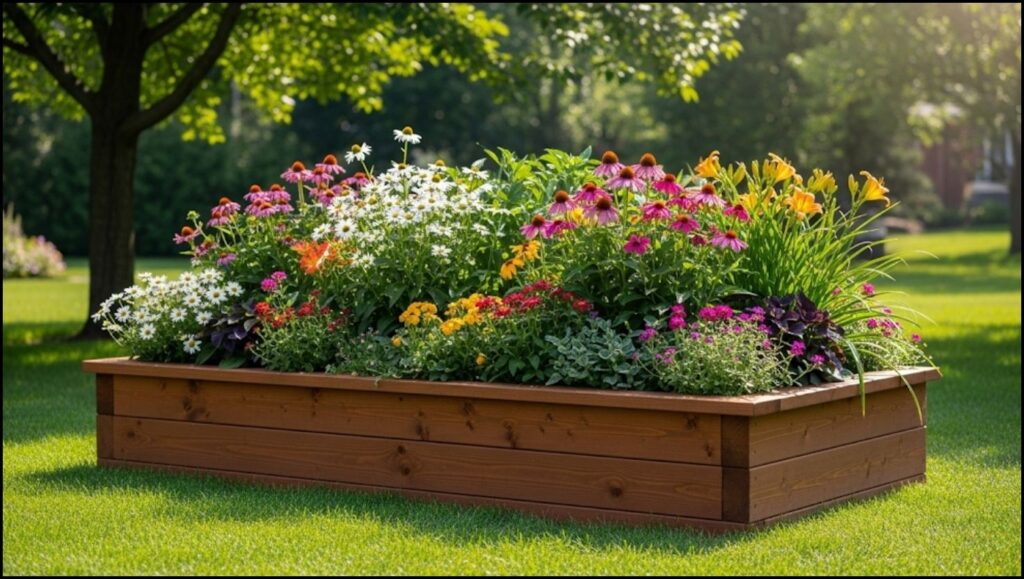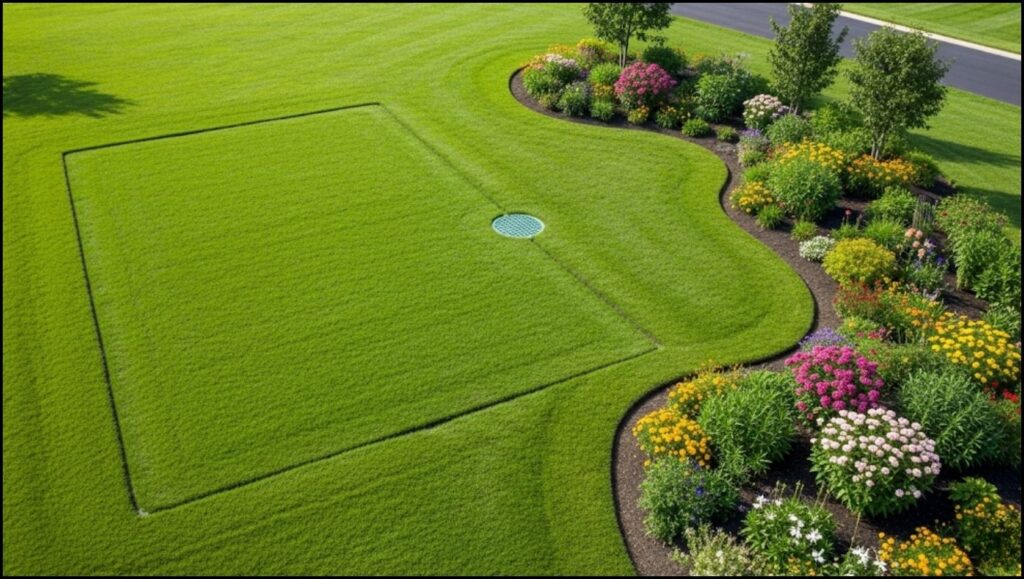Homeowners eager to enhance their property with vibrant gardens often overlook a critical, unseen risk: the network of pipes and cables just beneath the soil. Creating beautiful flower bed designs that work with underground plumbing is not just an aesthetic challenge but a crucial safety measure to prevent costly service disruptions and dangerous accidents.

Key Insights: Landscaping Over Utilities
| Key Principle | Detail & Best Practice |
| Know What’s Below | Before any digging, call 811 in the U.S. or your local one-call utility location service. This free service marks the approximate location of buried lines. |
| Respect Setbacks | Maintain a “tolerance zone,” typically 18-24 inches on either side of marked lines, where only hand digging is advised. |
| Choose Plants Wisely | Opt for shallow-rooted plants like annuals, grasses, and certain perennials. Avoid trees and large shrubs whose roots can invade and damage pipes. |
| Mind the Weight | Do not build heavy structures like retaining walls or place large mounds of soil directly over sensitive infrastructure, especially septic systems. |
The Hidden Dangers Beneath the Garden
As spring and summer inspire gardening projects nationwide, utility officials are issuing reminders about the significant risks of uninformed digging. A misplaced shovel can strike a water main, gas line, or fiber-optic cable, leading to expensive repairs, loss of essential services for a neighborhood, and even serious personal injury.
“Every digging project, no matter how small, warrants a free call to 811,” said Sarah K. Magruder Lyle, President and CEO of the Common Ground Alliance (CGA), a national association dedicated to preventing damage to underground infrastructure. According to CGA data, an underground utility line is damaged once every few minutes in the United States, often due to a failure to check for buried lines beforehand.
The solution is not to abandon landscaping ambitions but to adopt strategies that harmonize garden aesthetics with utility safety. Experts in horticulture and landscape design have developed several proven methods for creating stunning gardens in these sensitive areas.
7 Clever Flower Bed Designs for Areas with Buried Pipes and Cables
For homeowners looking to beautify their yard without compromising safety, landscape architects and horticulturists recommend several specific design approaches. These methods prioritize visibility, access, and the use of appropriate materials and plants.
1. The Elevated Raised Garden Bed
One of the most effective solutions is the use of raised garden beds. By building a structure above the existing ground level, the gardener has complete control over the soil depth, ensuring it remains shallow enough to prevent interference with pipes buried below.
“A raised bed of 6 to 12 inches is typically sufficient for most annuals and perennials,” advises the Purdue University Extension in its gardening guides. This design physically separates the garden’s root zone from the utility lines, providing a clear buffer. It also creates a defined edge, making the location of the underlying utility easement clear.
2. The Container Gardening Strategy
For maximum flexibility and zero ground disturbance, container gardening is an ideal choice. Using an array of pots, troughs, and decorative containers allows for vibrant plant displays directly over utility lines or areas requiring frequent access, such as a water meter.
This method is particularly useful for renters or for homeowners who may need to move their garden display quickly. The containers can be rearranged seasonally and completely removed if utility workers require access, ensuring no plants are destroyed during maintenance.

3. The Shallow-Rooted Perennial Meadow
This design focuses on plant selection as the primary safety mechanism. It involves creating a meadow-like garden using exclusively shallow-rooted plants. Most turf grasses, annual flowers (like petunias and marigolds), and many herbaceous perennials (such as coneflowers, hostas, and daylilies) have fibrous root systems that primarily inhabit the top foot of soil.
“The key is avoiding plants with aggressive taproots or extensive woody root systems,” states a publication from the University of New Hampshire Extension. “A well-chosen mix of perennials and ornamental grasses can provide years of beauty without threatening buried infrastructure.”
4. The “Island” Bed with Clear Access Paths
Rather than planting directly over a known utility line, this design creates a garden bed, or “island,” adjacent to it. A clear path of grass, mulch, or gravel is left directly over the utility path, ensuring an unobstructed route for maintenance crews. The garden bed itself can be densely planted, providing the desired visual impact while respecting the utility easement.
5. The Mulch Garden with Potted Accents
For a low-maintenance approach, a homeowner can lay down landscape fabric and cover a sensitive area with several inches of organic mulch or decorative stone. This suppresses weeds and clearly defines the area. To add color and interest, large container plants can be strategically placed on top of the mulch, combining the benefits of container gardening with a clean, unified groundcover.
6. The Vertical Garden Wall
In areas with a high concentration of underground utilities, such as narrow side yards, the safest place to garden may be up. A vertical garden, mounted on a fence or an exterior wall of the house, moves the entire planting area away from the ground. This innovative solution allows for growing herbs, flowers, and even some vegetables without any risk of ground disturbance.
7. The Septic-Safe Groundcover Field
Landscaping over and around septic system components requires special care. The U.S. Environmental Protection Agency (EPA) explicitly warns against planting anything other than grass over a septic tank and drain field, as roots from trees and shrubs can clog and destroy the system. Heavy structures and excess soil are also forbidden.
The safest design for planting over septic systems involves using only turf grass or a low-growing, herbaceous groundcover with very shallow roots. This maintains the drain field’s ability to function properly and prevents thousands of dollars in potential damages.

Planning for a Safe and Beautiful Landscape
Ultimately, a successful garden in a sensitive area is a product of careful planning. Before purchasing plants or breaking ground, experts unanimously agree that the first step is always to identify what lies beneath the surface.
By choosing a design that respects the location and function of underground utilities, homeowners can cultivate a beautiful garden that thrives for years without posing a risk to the essential services that communities rely on. The key is to see these unseen limitations not as barriers, but as creative challenges that can lead to smarter, safer, and more innovative garden designs.
Beyond the Border: Homeowners Embrace Fence Line Flower Bed Ideas to Maximize Outdoor Space
